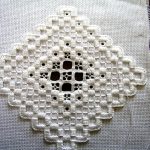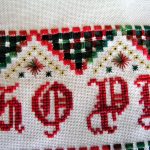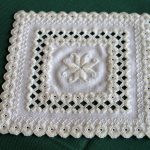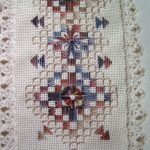Laurie Olson Williams teaches Hardanger embroidery at Ingebretsen’s. We asked her to tell us a little about the history of this needlework form and to share some samples of her own beautiful Hardanger work.
Laurie writes…
Hardanger embroidery, developed in the Hardanger Fjord region of Norway, spans an interesting gap between embroidery and lace making. Technically in the family of drawn thread embroidery (where threads are secured and then withdrawn from the ground cloth to make decorative openings), it is also worked extensively with satin stitch and various pulled thread stitches (eyelets and 4-sided stitch). It can be quite lacy, with large areas of threads removed from the ground cloth to make spaces for various decorative stitches, but any piece of Hardanger starts out as whole cloth – a distinct difference from the more usual thread laces, where the working thread itself is manipulated to make designs.
Thought to have originated in Persia, and brought to Norway via Italy (where it developed into a form of lace known as reticella), Hardanger was first used as a means of making lace from whole cloth, much like eyelet lace. Linen was the choice of both cloth and thread in the past, both because flax was grown extensively in northern Europe and because it was easily cleaned and bleached, making it the first choice for both men’s and women’s shirts. The embroidery/lace itself was done in matching white linen thread, both because it could then be easily cleaned without damaging the color, and because frankly, linen did not at the time take strong colors well and retain them through washing. The cloth used at the time was much finer than the 22 threads to the inch fabric “traditionally” used now – a 19th-/early 20th-century example that I was able to examine had a thread count that I estimated between 36 and 40 threads to the inch, but with the same characteristic basket weave as the the Hardanger cloth most used in today’s patterns.
Flourishing from about the mid-17th- to the mid 19th-century, Hardanger was used primarily as decoration on clothing – women’s collars and cuffs, but also extensively embroidered aprons, as well as on household items such as tablecloths. A bride from the Hardanger region would often carry a beautifully embroidered cloth in place of a bouquet. The clever needleworker would make sure that the tablecloth pattern could be stitched in stages, thereby making the cloth useable before it was completed. When it gained popularity in America in the early 20th-century, it was advertised as “easily done, and (is) not trying to the eyes or the nerves.” Except, perhaps, when making the first cut into a large piece of embroidery!
Modern interpretations of Hardanger often take advantage of the new over-dyed and hand-dyed fibers available. Far from detracting from the work, colored and variegated threads simply update the look. I do find that using brightly colored threads on a white or cream background means that you have to be very careful about cutting threads, as the cut ends stand out so much more! Care does not need to be taken in color choice so that the details of the open work are not lost, but overall, whether done in traditional white or modern over-dyed, Hardanger is indeed a surprisingly simple form of needlework that can look very complex.
–Laurie Olson Williams




Any classes coming up in 2016?
Yes, we will be offering more Hardanger classes this year, probably in early summer and definitely in the fall. Please check our class listings at http://www.ingebretsens.com for updates.